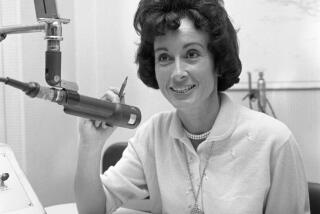Ruth Patrick dies at 105; pioneer in freshwater ecosystem research
- Share via
Ruth Patrick, a scientist whose research on freshwater ecosystems led to groundbreaking ways to measure pollution in rivers and streams, has died. She was 105.
Patrick, recipient of dozens of the nation’s top science awards including the National Medal of Science, died Monday at a retirement community in Lafayette Hill, Pa., according to the Academy of Natural Sciences at Drexel University. The cause was not given.
Patrick is credited with creating an approach that assesses the health of a lake, stream or river by evaluating the quantity, diversity and health of its plants, insects, fish and other organisms — not solely examining the chemistry of the water.
“Basically she demonstrated biological diversity can be used to measure environmental impact,” conservation biologist Thomas Lovejoy told the academy. “I call that the Patrick Principle and consider it the basis for all environmental science and management.”
Patrick also devised a tool to detect water pollution by measuring microscopic algae called diatoms. She is credited with being the first scientist to recognize that different kinds of diatoms prefer different environments and therefore can shed light on water quality.
Patrick spent nearly her entire career at the Academy of Natural Sciences in Philadelphia. She continued to work there into her late 90s and often had lunch at the museum’s cafe so she could sit anonymously among excited schoolchildren on class trips.
She was “essentially a den mother for a couple of generations of scientists,” according to Lovejoy, president of the H. John Heinz III Center for Science, Economics and the Environment.
Patrick received dozens of prestigious awards throughout her career including the National Medal of Science, which she received from President Clinton in 1996. She taught limnology — the study of freshwater rivers and lakes — and botany at the University of Pennsylvania for more than 35 years and wrote more than 200 scientific papers and several books on the environment.
She advised President Johnson on water pollution and President Reagan on acid rain.
Patrick first came to the Academy of Natural Sciences in 1933 as a graduate student studying diatoms. One of the few women in the sciences, she later recalled that she wore pants instead of dresses to better blend in with male colleagues.
She worked as an unpaid researcher and volunteer until she was put on the academy’s payroll in 1945. Two years later, she established the department of limnology, now called the Patrick Center for Environmental Research.
Patrick was born Nov. 26, 1907, in Topeka, Kan., and spent most of her childhood in Kansas City, Mo. She became interested in the natural sciences at about age 5, when her father took Ruth and her sister on expeditions in woods near the family’s home. At 7, she was given her first microscope.
She went on to study biology and received a bachelor’s degree in 1929 from Coker College in Hartsville, S.C. She received a master’s degree in 1931 and a doctorate in botany in 1934, both from the University of Virginia.
The Ruth Patrick Science Education Center at the University of South Carolina is named for her, as is a wetlands preservation site along the Savannah River.
Patrick’s first husband, entomologist Charles Hodge IV, died in 1985. Her second husband, attorney Lewis Van Dusen, died in 2004. She is survived by a son, Charles Hodge V, a gastroenterologist in Kansas City, Mo.; three stepchildren and several grandchildren.
Loviglio writes for the Associated Press.
More to Read
Start your day right
Sign up for Essential California for the L.A. Times biggest news, features and recommendations in your inbox six days a week.
You may occasionally receive promotional content from the Los Angeles Times.





